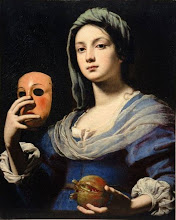In this detail from the Sistine Chapel, Michelangelo depicts the serpent in the Tree of Knowledge as a female entity. Serpents are ancient symbols of wisdom associated with the Goddess. It's interesting that Michelangelo visually links, through juxtaposition and hair colour, the serpent of wisdom and the angel driving Adam and Eve out of Eden, suggesting almost that they were one being, a single aspect of the Self which manifested to push humanity out the blissful ignorance of a pre-human, animal-like state into a higher level of evolution.
For Wisdom, the fashioner of all things, taught me. For in Her there is a spirit that is intelligent, holy, unique, manifold, subtle, mobile, clear, unpolluted, distinct, invulnerable, loving the good, keen, irresistible, beneficent, humane, steadfast, sure, free from anxiety, all-powerful, overseeing all, and penetrating through all spirits that are intelligent and pure and most subtle. For Wisdom is more mobile than any motion; because of Her pureness she pervades and penetrates all things.
- The Book of Wisdom of Solomon (Volume IV)
Book of Wisdom or Wisdom of Solomon or simply Wisdom is one of the deuterocanonical books of the Bible. It is one of the seven Sapiential or wisdom books of the Septuagint Old Testament, which includes Job, Psalms, Proverbs, Ecclesiastes, Song of Solomon (Song of Songs), and Ecclesiasticus (Sirach).
There are instances in the book of Proverbs where Wisdom is personified as a female. Female imagery begins the book of Proverbs in Chapters 1-9 and also ends the book in chapter 31. In Proverbs 9:1-6 she is depicted as a figure with a home inviting those in need of wisdom to enter. She says "Come, eat of my bread and drink of the wine I have mixed. Lay aside immaturity, and live, and walk in the way of insight." In Proverbs 8:15-21, she not only identifies herself as the divine companion, but also as the source of order in society and success in life. In chapter 31:10 she is personified as the ideal woman for an Israelite man in a section titled Ode to a Capable Wife. There is debate about the status and place of Woman Wisdom in relation to the divine. Some have interpreted her as a companion to the divine, an abstraction, an extension to the divine, or a Goddess. Further information about the nature of Wisdom is found in Proverbs 8:22-30. In these verses "wisdom speaks of herself as having been created before anything else and as Yahweh's companion and even assistant at the creation of the ordered world." It has also been argued that personifying Wisdom as a woman adds a mythical nature to proverbs. This would line up with the ancient Near Eastern view that every male deity had a female counterpart.
-Wikipedia
























